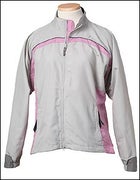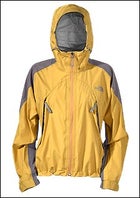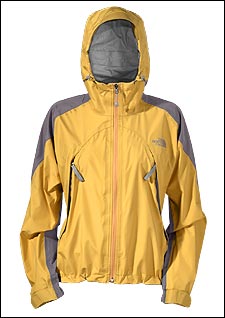Last weekôs Outdoor Retailer Summer Market in Salt Lake City was the usual barely controlled insanity: More than 800 exhibitors and tens of thousands of products on display. It was far too much for any mortal to take in during three days, but as I sorted through the chaos, several trends emerged among the products that will be hitting stands in the coming months.
 Deep knee bend: Marmot’s Mercury Tent
Deep knee bend: Marmot’s Mercury Tent Sierra Design’s Sirocco Jacket
Sierra Design’s Sirocco Jacket Heavy breather: The North Face’s women’s Atmosphere jacket
Heavy breather: The North Face’s women’s Atmosphere jacket
THE PRICE IS RIGHT
Wow, itôs getting NASTY out there, as outdoor gear manufacturers are dropping gloves and throwing punches in the form of price cuts. Two years ago, gear makers wouldnôt blink when unveiling their latest $1,200 Gore-Tex unisuit. No more. Good raingear can be had for less than $200ôsometimes much lessôvery fine boots for $150, decent day packs for under $100, and so on. The North Face, for instance, was showing a good quality, 30-degree down sleeping bag that will sell for $150ôthe price a decent synthetic went for two years ago.
Iôm a little worried that a flood of cheap outdoor gear will backfire on the market if people end up with stuff that breaks, wears out, or just doesnôt work as well as claimed. But clearly, in most cases the customer is the winner. Example: Marmotôs Mercury tent, which incorporates new, light, strong fabrics, pre-bent DAC super-light poles with corner ôkneesô that both resist wind and increase interior space, plus all the usual Marmot features such as lots of interior pockets and taped bathtub floors. The new fabrics and poles cut the weight of this three-season, two-person tent to just under five pounds. But the price is $299, the same as the heavier, smaller tent the Mercury replaces in the Marmot line. Elsewhere it was obvious that manufacturers were putting tremendous pressure on suppliers to drop prices on existing materials or come up with less-expensive ones that work as wellôor damn close to itôas the high-priced stuff.
LADY’S CHOICE
Gear makers have been paying increasing attention to women for five or six years, but what had remained something of a shuffle in that direction is now a stampede. Companies such as Sierra Designs, which unveiled the breathable, lightly insulated Women’s Sirocco Jacket ($79) among other new women’s and men’s only pieces, no longer even offer ôunisexô stuff. I even heard someone with one of the big manufacturers tell me that womenôs designs are created first, and the menôs spun off from that. Everyone wins hereôwomen get stuff thatôs styled thoughtfully for them, with features such as a zippered pocket placed on a sleeve rather than stuck over a breast. And men getô well, maybe not everyone wins. I thought most of the womenôs stuff looked better than the menôs.
FABRICOLOGY
In years past, the ônewsô at the show tended to revolve around one or two big new fabric innovationsôPolarguard 3D, for instance, or Gore-Tex XCR. This year, it seemed to me, a bunch of small improvements are adding up to pretty significant changes. The sheer volume of new, high-tech materials is astonishing. ôI just canôt keep up with it allôthereôs almost too much to choose from,ô Randy Verniers, Marmotôs technology guru, told me, alluding to the dozens of fabrics, insulations, zippers, molded plastic clips and other stuff flogged in the showôs remote corners.
With so much to choose from, gear designers are unleashing some real creativity. Itôs not uncommon now to see a single garment that might contain fabric from Gore (Windstopper), Schoeller (Dryskin), Malden Mills (Polartec), DuPont (CoolMax) and one or two other makers, each chosen for a particular quality and used in a particular part of the garmentôfor wear-resistance at the elbow, ventilation at the back, water-resistance across the shoulders, and warmth around the torso. End result: The gear on dispaly at the 2002 show was lighter, more versatile, and better performing than anything that’s been on the market thus far.
Not that every change was ôlittle.ô A wonderfully named company called Perseverance Mills, for instanced, introduced a terrific variation on its long-popular Pertex nylon fabric. Called Quantum, itôs an incredibly light and tightly woven fabricôonly .six ounce per square yard, and naturally down-proof by nature, so it doesnôt need to be ôcalendered,ô a process that makes for a stiffer fabric. Quantum popped up in sleeping bags from Western Mountaineering, Marmot, and others, resulting in bags such as Westernôs Pod 30, a 30-degree bag with no insulation on the bottom. Bag and sleeping pad weigh less than two pounds and will retail for a combined $280.
And there is one promising development on the rainwear horizon: Next year Lowe Alpine will introduce rainwear made with eVENT, a waterproof-breathable fabric developed by BHA Technologies. Like Gore-Tex, eVENT is an expanded polytetrafluoroethylene (PTFE) fabric. But unlike Gore-Tex, it doesnôt require an extra coating to make it oil-resistant. Thatôs a big step, as body oil and dirt can otherwise open channels through the material and allow rain to seep in. The eVENT technology, now used in garments made by Pearl Izumi, promises to breathe better than anything else out there. It wonôt be cheapôLowe Alpine says it will sell for as much or more as Goreôs premium XCR fabricôbut my guess is that Lowe will try to undercut Gore a little on price in order to gain market.
Gore, meanwhile, isnôt taking this news without a fight. The North Face was showing a line of jackets made with yet another Gore-Tex formulation that is said to be the most breathable Gore-Tex yet made. Price for the Atmosphere jacket: A very competitive $279.
SHOW NOTES
Overall, I thought Marmot had the best top-to-bottom lineup at the show, with good-looking clothing including a more-breathable version of its wildly popular PreCip jacket and pants, well-designed tents and sleeping bags, and an increasingly comprehensive pack line. Mountain Hardwear was showing sleeping bags made with its waterproof Conduit laminate that featured welded seams. (Meaning: No stitching to hold the down baffles in place, so the bag cannot leak, creating a sleeping bag and bivy bag in a single unit.) Another of the big names, Sierra Designs, was showing a new line of tents that can literally be unzipped down the middle, converting a two-person tent to a one-person, and a three-person to a two-person. A clever idea, but consumers typically resist ômulti-purposeô products such as that, so weôll see.
The ultralight influence continues to grow, led by GoLite, which has new clothing in its 2003 lineup, plus improved packs and new sleeping bags. Other companies also are trimming weight and unnecessary add-ons. One result of all this: You just donôt see introductions of enormous new packs. And even heavy-duty stuff is shedding ounces. Tecnica, for instance, is introducing a new mountaineering boot that shaves several ounces from its predecessor by trimming part of the nylon shank and using new lightweight materials. Itôs called the T-Rock, and will sell for $340ôa bargain. MSR, meanwhile, introduced two new lightweight stoves: the liquid-fuel SimmerLite (8.5 ounces, $90) and the canister-fuel WindPro ($60). The SimmerLite in particular, with a new stove design that helps low-flame cooking, should sell well.
As usual, the products that most caught my eye were relatively obscure ones. An example: the Light My Fire firesteel. A Swedish import, itôs a specially treated metal rod and striker than can give you up to 4,000 big sparks in the small Scout model ($10). Itôll light a gas stove, or dry kindling, and will do so even if itôs wet. Definitely worth carrying. I also liked High Gearôs new AltiTech altimeter/watch/compass ($140), a hand-held iteration on this useful gadget that incorporates a carabiner-style clip so it attaches easily to a pack harness.
And if youôre in Salt Lake City soon, definitely make a stop at the Red Iguana restaurant on North Temple and have a plate of Cochinita Pibilôthe perfect remedy for an over-geared mind.


